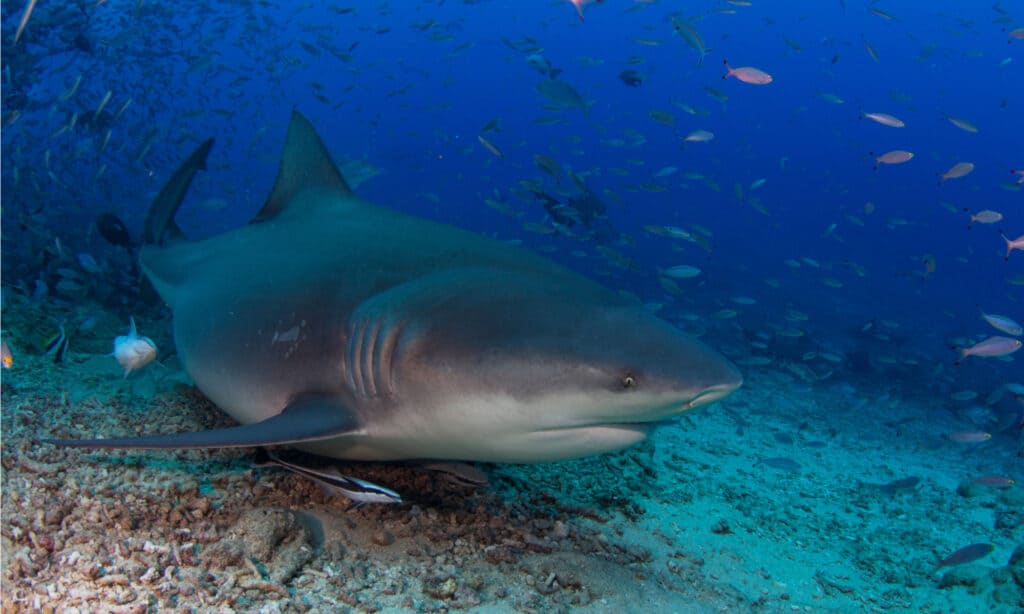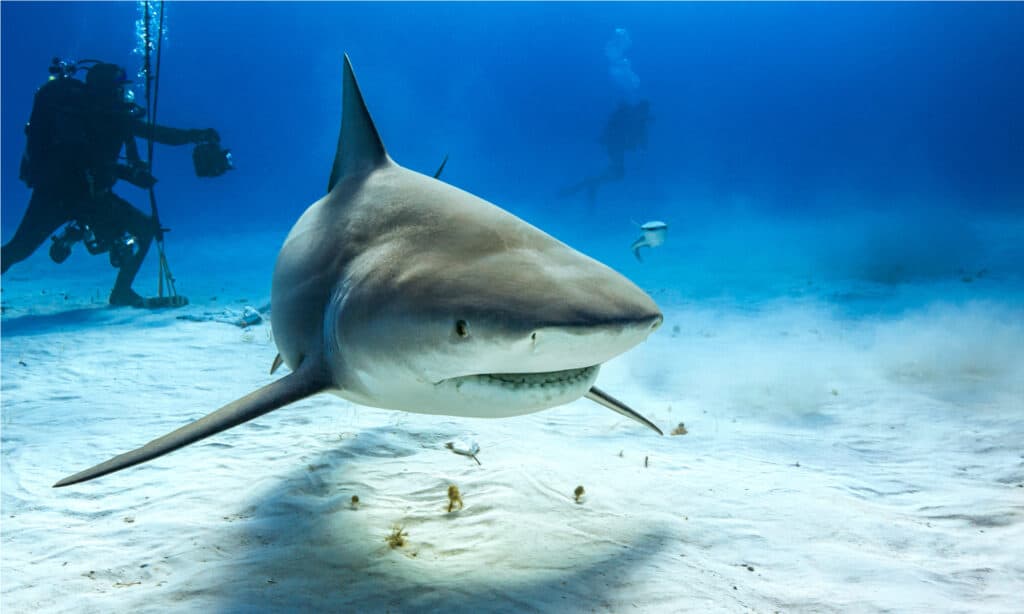While playing a relaxing game of golf, the last thing you’d ever expect to encounter on the course is a shark. Yet that is exactly what you can meet at a golf course in Australia. That’s right, the Carbrook golf course in Queensland is the world’s only shark-infested golf course where its lake has its resident population of bull sharks. When we think of sharks, we instantly think of them as living only in the sea, so how on earth did there ever come to be sharks in a lake? Join us as we discover exactly why this one lake in Australia is home to aggressive bull sharks!
About Bull Sharks
Bull sharks (Carcharhinus leucas) are large, stocky-bodied sharks that can reach around 11 feet in length and weigh up to approximately 500 pounds. They are solitary hunters and typically prey on a wide variety of food. Their diet usually includes bony fish, smaller sharks, turtles, birds, crustaceans, and dolphins.
However, as well as being opportunistic feeders, bull sharks are known for their particularly aggressive nature. Although great white sharks are generally believed to be the most dangerous, bull sharks are close up there with them.
Although bull sharks typically live in warm, shallow water all around the world, they are famous for their ability to travel hundreds of miles up rivers, which poses the question of how they can do it. There are a few species of sharks that can live in freshwater. Some live exclusively in rivers and are known as true river sharks, while others only come and go. Bull sharks come under this latter category, despite being better known for their marine exploits. One of fascinating things about these sharks is their ability to survive – and thrive – in an environment that they really shouldn’t be able to.
Bull Sharks Trapped in a Lake!

Australia is home to a shark-infested lake with a population of bull sharks.
©Aquarius Traveller/Shutterstock.com
Despite being completely unexpected, there is a 52-acre lake in the center of the idyllic Carbrook golf course, which is home to its population of bull sharks. Miles from the sea, these bull sharks are trapped there with no way in or out for them. But how did they even come to be there in the first place?
As we’ve just mentioned, bull sharks regularly swim hundreds of miles up rivers, and this is exactly how they ended up at Carbrook. After bad weather in 1996, the local rivers flooded. This allowed bull sharks that had already entered them to swim through the floodwater and end up at the lake in the center of the course. Incredibly, when the floodwaters receded, the sharks were left trapped there in the lake and have remained there ever since. Given the vast size of the lake and its healthy fish stocks, the bull sharks which were trapped there were able to survive. In fact, rather than just surviving, they are thriving. Initially, there were only six bull sharks that were left at Carbrook after the floods. However, recent reports suggest that there are now as many as twelve bull sharks in the lake!
Despite their aggressive nature making retrieving stray golf balls or swimming in the lake a really bad idea, the bull sharks at Carbrook serve as a popular tourist attraction. The breathtaking beasts regularly swim close to the shore, allowing people to see them from as near as only 6 feet away. Additionally, the golf club even holds a monthly tournament which is known as “Shark Lake Challenge.” Thankfully, the tournament is a golf competition rather than anything actually involving the sharks, though!
But how do they Survive?

Bull sharks are uniquely adapted to surviving in freshwater.
©Carlos Grillo/Shutterstock.com
By now, you’re probably wondering just how bull sharks can survive in entirely freshwater. The answer is actually really simple – they are uniquely adapted to it.
Sharks don’t have swim bladders. Therefore, they rely on their oil-filled livers to help them to stay afloat instead, as oil is lighter than water. Saltwater is more buoyant than freshwater so to compensate freshwater sharks require much larger livers which hold more oil to keep them afloat. This is why river sharks tend to have stockier bodies than marine sharks.
Additionally, most sharks contain a lot of salt – usually enough so that they are slightly saltier than the sea. This allows them to keep their salt inside them while they take in water through their gills and filter out what they don’t need. However, if they are in freshwater, then the salt in their bodies becomes diluted. This means that their kidneys have to work harder to get rid of it. In most cases, this weakens the sharks and causes dehydration and eventually death. This is the reason that most marine sharks can’t tolerate freshwater for long.
However, bull sharks don’t contain as much salt in their bodies as other marine sharks. This makes it much easier for them to spend time in freshwater. Their kidneys still need to work hard to remove the extra freshwater that they take in. However, they do this by urinating around twenty times more in freshwater than they do in saltwater. Also, their livers produce urea when needed, depending on the salinity of the water they are in. This means that bull sharks can regulate their bodies depending on whether they are in saltwater or freshwater – allowing them to survive in either habitat successfully.
The photo featured at the top of this post is © Carlos Grillo/Shutterstock.com
Thank you for reading! Have some feedback for us? Contact the AZ Animals editorial team.






